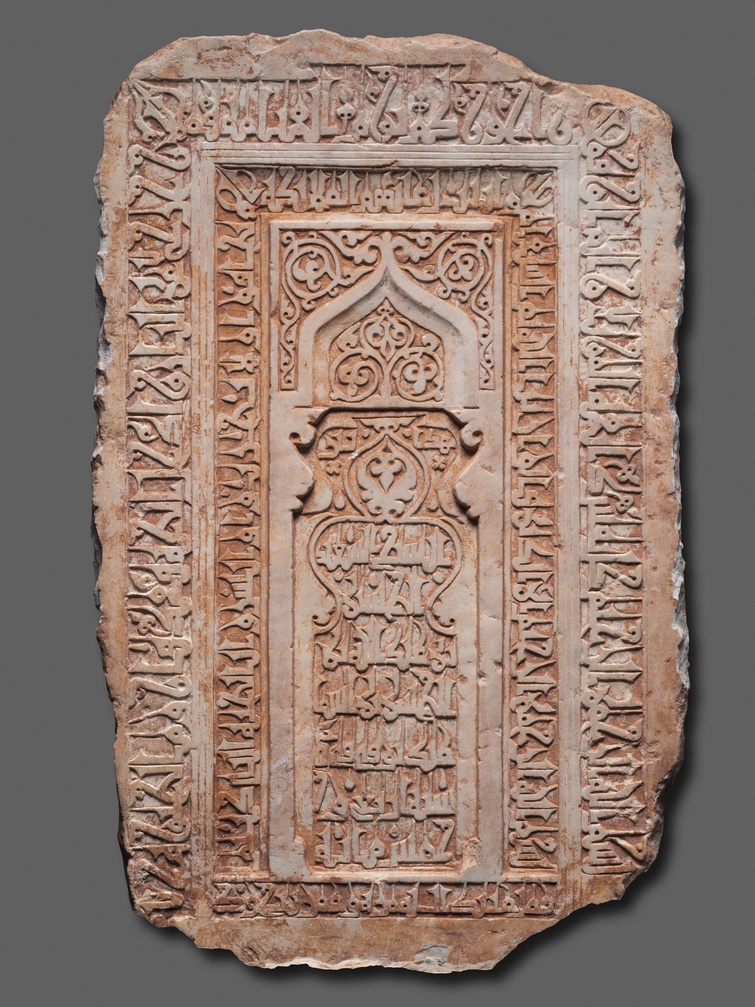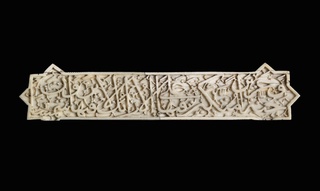Honoring the Dead: Funerary Ornamentation and Ritual in Islam
By Isoken Osage and Content Team •July 2022•6 Minute Read

In Islamic cultures, some funerary objects, tombstones, and grave markers that commemorate the dead are adorned with verses from the Qur’an. These dedications illustrate the versatility and dexterity of Islamic calligraphy and calligraphers, while representing changes in commemorative practices over time and across cultures.
Introduction
Prophet Muhammad requested to be buried “in an unmarked grave in one of the chambers of his house." In 633 CE, the prophet’s body was interred directly under the bed where he’d spent his final days. Following Muhammad, in the early days of Islam, marking gravesites with anything more elaborate than an unworked stone was discouraged. The Hadith, the collected reports and record of the words and actions of Muhammad, states that Muslims should "condemn the building of tombs.”
However, over the years, architectural influences, especially from the Byzantine empire (c.330–1453 CE) and Sassanian empire (7th–8th centuries CE), coupled with strong local traditions that predate Islam, led to the emergence of a range of decorated commemorative works, from small processional objects to larger funerary monuments.
Muhammad’s burial site did not stay unadorned for long. In 707 CE, the Umayyad caliph al-Walid I expanded Al-Masjid an-Nabawi (the Mosque of the Prophet). The new footprint of the mosque enclosed the house where Muhammad (along with two succeeding caliphs) is buried. The walls were torn down and an ornate five-sided sacred chamber built to protect the graves.
The burial site continued to evolve, with various demolitions and additions, including the erection of a wooden cupola in the 13th century. The tomb took its present form in the 1800s when the dome was simplified, reinforced, and painted green. Supposedly, no one has laid eyes on Muhammad’s grave since 1481.
Islamic Funeral Rites
Islamic funerals are guided by the Qur’an, even though regional customs affect how strictly these guidelines are followed. Under Islamic Sharia law, certain rites must be observed. The deceased are buried as soon as possible, usually within 24 hours of death. Cremation is forbidden.
Prescribed burial rituals are simple and precise: bathing the body, wrapping the body in white cotton or linen cloth, reciting Salat al-Janazah to seek the pardoning of the deceased and all dead Muslims, and positioning the body’s head towards Mecca.
Unknown, Funeral of Imam Husayn, mid to late 19th century, Qajar period. Brooklyn Museum of Art. This work may depict the funeral of Imam Husayn and was likely a part of a larger manuscript.
Gravesites are expected to be plain. Notable rulers, royalty, and esteemed religious figures are often buried in graves as simple as Mohammad’s, covered in pebbles and capped by unadorned stone markers. The Hadith allows graves to be raised or otherwise marked only when this is necessary for identifying them. In some cases, simple inscriptions are included on a sarcophagus or tombstone.
Ornamental Funerary Objects and Monuments
Despite the Sharia law, the existence of finely carved Islamic headstones show that not all Muslims interpret the invocation to sober burials in the same way. As archeologist and Islamic scholar Timothy Insoll notes in his book, The Archaeology of Islam (1999), more elaborate and decorative tombs and funerary architecture provide means of "moving beyond the strictures of formal Muslim burial rites." The same could be said for funerary objects including plaques and textiles.
Tombstones
Tombstones could be carved to resemble architectural features of mosques, such as the pointed archways that orient worshipers toward Mecca.

More elaborate tombstones often include verses from the Qur’an and the Hadith, as well as the individual’s name and death date. In the most elaborate examples, the artist incorporates their signature. Geometric and calligraphic motifs provide decoration. However, in accordance with Islamic tradition, artists avoid representations of animals and people.
Plaques
Decorated plaques serve a similar purpose, and are typically installed on the walls of mausoleums or shrines. The texts that wrap around depictions of architectural features include Qur’anic verses and prayers for the deceased.
Textiles
Ornamental textiles such as kiswahs and cenotaph covers are used in draping funerary grounds, tombs, and monuments. Cenotaphs are empty tombs or monuments in honor of a person or group of people whose remains are buried elsewhere. Kiswahs are reserved for the Kaaba, a cubic building at the center of the Great Mosque of Mecca, which serves as the qibla, the direction of prayer for Muslims.

Abdullah Shakoor, The Kiswah covering the Kaaba in Mecca, 2016. Pixabay, CC0. The Kiswah is a richly embroidered cloth covering on the Kaaba, a sacred building in the center of the Masjid al-Haram in Mecca, towards which all Muslims face when they pray.
Worldwide Rituals of Mourning
In addition to objects found on or around burial sites, funerary articles like professional standards and banners (‘alams) are used to commemorate significant deaths.
‘Alams are used during Ashura. Ashura is the tenth day of the month of Muharram, one of the four sacred months in Islam when warfare is forbidden.
For Shia Muslims, Ashura marks the day that Husayn ibn Ali (also known as Imam Husayn), grandson of the Prophet Muhammad, was killed in the famous Battle of Karbala in 680 CE. Honoring this tragedy, two commemorative events take place worldwide across Shia cultures as part of Muharram. They are the Ta’ziya and the Tuwairij run.
Abbas Al-Musavi, Battle of Karbala, late 19th-early 20th century, Qajar Period. Brooklyn Museum of Art. Vivid paintings like this work by Abbas Al-Musavi, were commonly used as backdrops in theatrical reenactments of battles known as Ta’ziya.
Ta’ziya
Commonly referred to as the Muslim Passion Play, Ta’ziya is primarily an Iranian tradition that involves the theatrical reenactment of the Battle of Karbala by Shia Muslims. Vivid and violent paintings were used as backdrops or curtains for Ta’ziya. These plays date back to the 17th century and were especially prevalent during the Qajar dynasty. They lost popularity in the early 20th century, although elements of Ta’ziya remain in modern Iranian theater.
A Ta’ziya procession in Chinot, Pakistan, July 26, 2010. Wikimedia Commons, user: Tahseen72. CC BY SA 4.0. Worshipers fill the street on Ashura, a Muslim holy day, some carrying replicas of the tomb of Imam Husayn.
In South Asia and the Caribbean, the Ta’ziya has evolved into replicas akin to miniature mausoleums. The small structures imitate the tomb of Imam Husayn. These ephemeral replicas are usually made of bamboo and colored paper. They are carried during Muharram processions like the one seen in this image.
Tuwairij Runs
Mehran Hamzah, Tuwaijri run, 2019. Wikimedia Commons, user: Shiasun. CC BY 4.0. Observant Muslims undertake the Tuwaijri in 2019, packing the street and waving green flags to honor the slain Imam Husayn.
First observed in 1855, the Tuwairij is a ceremony on Ashura that millions of Shia Muslims partake in. A large crowd runs from a village in present-day Iraq called Tuwairij to the mausoleums of Imam Husayn and his half-brother, al-Abbas, in Karbala. Participants beat their heads and chests in sorrow. Symbolically, Tuwairij retraces the steps of the maternal cousins of al-Abbas who ran from the ancient village of Tuwairij to join the Battle of Karbala where Husayn was slain.
As part of such Tuwairij, processional standards or ‘alams are mounted on poles and enhanced with fabric streamers. These, too, might incorporate calligraphy, such as the names of religious figures.
Muhammad Taqi Ordubadi, 'Alam, 1664-1665. The Walters Art Museum. This ‘alam would have been mounted on a pole and adorned with fabric streamers to commemorate the martyrdom of Husayn.
Death is Not the End
The Islamic prohibition on decorative burial sites isn’t always considered absolute. Over the centuries, cultural and religious perspectives changed over time and across regions, resulting in rich funerary traditions. Plain graves have been transformed into elaborate shrines and attract throngs of pilgrims. And in some cases, in addition to the permanent structures over their gravesites, colorful rituals featuring thousands of supplicants honor the dead. God’s word on the subject may be final—but earthly interpretations continue to evolve.
Isoken Osagie is a contributor from the Curationist Content Team. She has worked on various curatorial projects including exhibitions at the Brooklyn Museum and Zoma Museum in Addis Ababa, Ethiopia. She is a graduate of The New School in New York City. Her interests include African literature, cultural heritage and the intersections of art and technology.
Suggested Readings
“Islamic funeral.” Wikipedia. en.wikipedia.org/wiki/Islamic_funeral. Accessed 15 July, 2022.
Insoll, Timothy, Salman Almaharai, and Rachel MacLean. The Islamic Funeral Inscriptions of Bahrain, Pre–1317 AH/1900 AD. Brill, 2019. brill.com/view/title/39066. Accessed 15 July, 2022.
Kazempour, M., and S. Shokrpour. “A Symbolic Analysis of the Islamic Period Gravestones in the Ahar Museum.” Int J Histor Archaeol 25, 1065–1086, 2021. https://doi.org/10.1007/s10761-021-00588-6. Accessed 15 July, 2022.
Isoken Osagie is a contributor from the Curationist Content Team. She has worked on various curatorial projects including exhibitions at the Brooklyn Museum and Zoma Museum in Addis Ababa, Ethiopia. She is a graduate of The New School in New York City. Her interests include African literature, cultural heritage and the intersections of art and technology.



